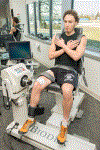The current management of patients with patellofemoral pain from the physical therapist's perspective
- PMID: 31414069
- PMCID: PMC6693858
- DOI: 10.21037/aoj.2018.04.11
The current management of patients with patellofemoral pain from the physical therapist's perspective
Abstract
Patellofemoral pain (PFP) is a common diagnosis that includes an amalgam of conditions that are typically non-traumatic in origin and result in peripatellar and/or retropatellar knee pain. The purpose of this review is to provide an overview of the physical therapist's management, including the evaluation and treatment, of the patient with PFP. A thorough history is critical for appropriately diagnosing and optimally managing PFP; the history should include the date of symptom onset, mechanism of injury and/or antecedent events, location and quality of pain, exacerbating and alleviating symptoms, relevant past medical history, occupational demands, recreational activities, footwear, and patient goals. Physical examination should identify the patient's specific impairments, assessing range of motion (ROM), muscle length, effusion, resisted isometrics, strength, balance and postural control, special tests, movement quality, palpation, function, and patient reported outcome measures. Objective assessments should guide treatment, progression, and clinical decision-making. The rehabilitation program should be individually tailored, addressing the patient's specific impairments and functional limitations and achieving the patient's goals. Exercise therapy, including hip, knee, and core strengthening as well as stretching and aerobic exercise, are central to the successful management of PFP. Other complimentary treatments may include patellofemoral and tibiofemoral joint mobilizations, patellofemoral taping, neuromuscular training, and gait retraining. Appropriate progression of interventions should consider objective evaluations (e.g., effusion, soreness rules), systematic increases in loading, and the chronicity of symptoms. Although short-term changes or reductions in movement often are necessary in a protective capacity, the persistence of altered movement is a key characteristic of chronic pain, which may be managed in part through emphasis on function over symptoms, graded exposure, patient education, and perhaps referral. PFP etiology is largely movement related and a comprehensive conservative treatment using movement can be successful.
Keywords: Patellofemoral joint; patellofemoral pain (PFP); physical therapy; rehabilitation.
Conflict of interest statement
Conflicts of Interest: The authors have no conflicts of interest to declare.
Figures


References
-
- Chen YJ, Scher I, Powers CM. Quantification of Patellofemoral Joint Reaction Force During Functional Activities Using a Subject-Specific Three-Dimensional Model. J Appl Biomech 2010;26:415–23. - PubMed
-
- Lankhorst NE, van Middelkoop M, Crossley KM, et al. Factors that predict a poor outcome 5–8 years after the diagnosis of patellofemoral pain: a multicentre observational analysis. Br J Sports Med 2016;50:881–6. - PubMed
-
- Biedert RM, Sanchis-Alfonso V. Sources of anterior knee pain. Clin Sports Med 2002;21:335–47. - PubMed
-
- Dye SF, Vaupel GL, Dye CC. Conscious Neurosensory Mapping of the Internal Structures of the Human Knee Without Intraarticular Anesthesia. Am J Sports Med 1998;26:773–7. - PubMed
Grants and funding
LinkOut - more resources
Full Text Sources
Miscellaneous
